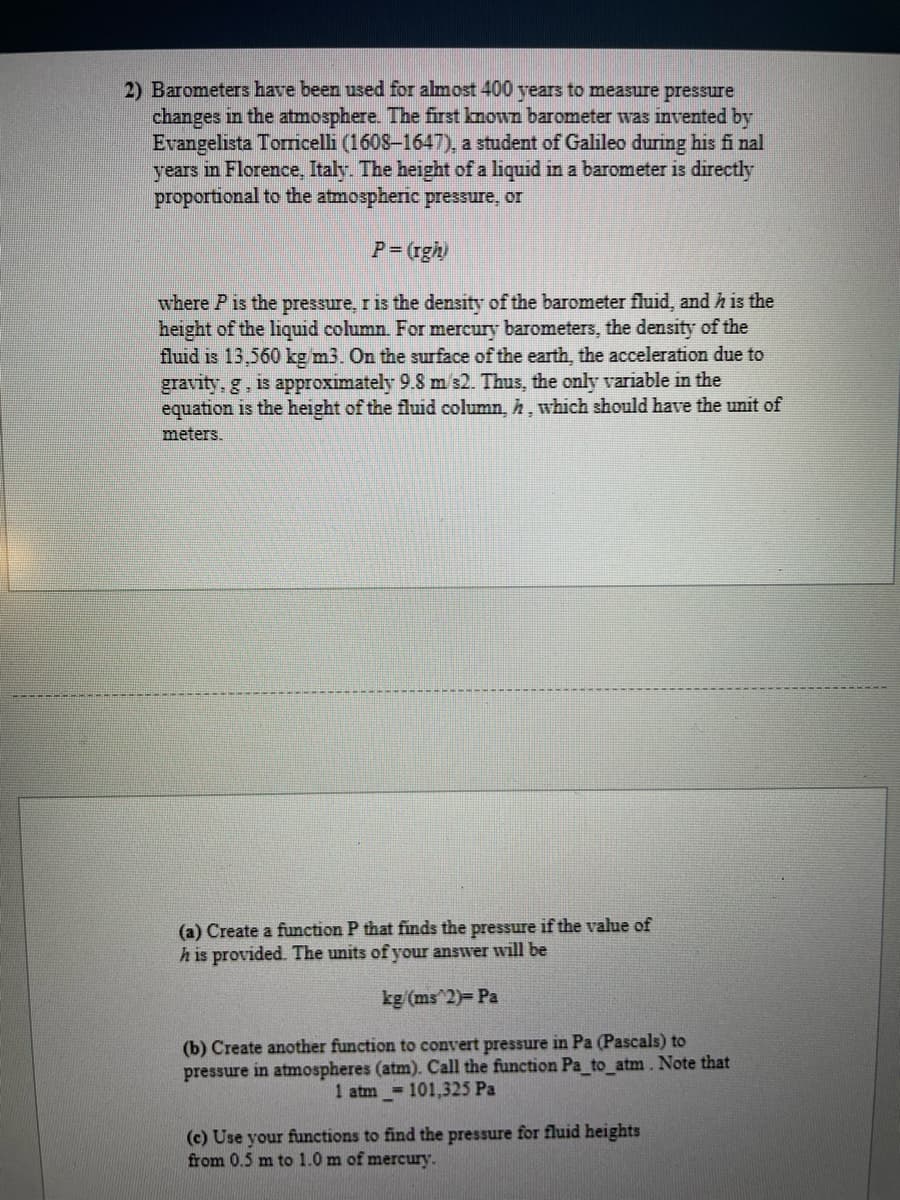Barometers have been used for almost 400 years to measure pressure changes in the atmosphere. The first known barometer was invented by Evangelista Torricelli (1608-1647), a student of Galileo during his fi nal years in Florence, Italy. The height of a liquid in a barometer is directly proportional to the atmospheric pressure, or P=(rgh) where P is the pressure, r is the density of the barometer fluid, and his the height of the liquid column. For mercury barometers, the density of the fluid is 13,560 kg/m3. On the surface of the earth, the acceleration due to gravity, g, is approximately 9.8 m/s2. Thus, the only variable in the equation is the height of the fluid column, h, which should have the unit of meters.
Barometers have been used for almost 400 years to measure pressure changes in the atmosphere. The first known barometer was invented by Evangelista Torricelli (1608-1647), a student of Galileo during his fi nal years in Florence, Italy. The height of a liquid in a barometer is directly proportional to the atmospheric pressure, or P=(rgh) where P is the pressure, r is the density of the barometer fluid, and his the height of the liquid column. For mercury barometers, the density of the fluid is 13,560 kg/m3. On the surface of the earth, the acceleration due to gravity, g, is approximately 9.8 m/s2. Thus, the only variable in the equation is the height of the fluid column, h, which should have the unit of meters.
Elements Of Electromagnetics
7th Edition
ISBN:9780190698614
Author:Sadiku, Matthew N. O.
Publisher:Sadiku, Matthew N. O.
ChapterMA: Math Assessment
Section: Chapter Questions
Problem 1.1MA
Related questions
Question
Help solve this USING MATLAB

Transcribed Image Text:2) Barometers have been used for almost 400 years to measure pressure
changes in the atmosphere. The first known barometer was invented by
Evangelista Torricelli (1608-1647), a student of Galileo during his fi nal
years in Florence, Italy. The height of a liquid in a barometer is directly
proportional to the atmospheric pressure, or
P = (rgh)
where P is the pressure, r is the density of the barometer fluid, and his the
height of the liquid column. For mercury barometers, the density of the
fluid is 13.560 kg/m3. On the surface of the earth, the acceleration due to
gravity, g, is approximately 9.8 m/s2. Thus, the only variable in the
equation is the height of the fluid column, h, which should have the unit of
meters.
(a) Create a function P that finds the pressure if the value of
h is provided. The units of your answer will be
kg/(ms^2)= Pa
(b) Create another function to convert pressure in Pa (Pascals) to
pressure in atmospheres (atm). Call the function Pa_to_atm. Note that
1 atm = 101,325 Pa
(c) Use your functions to find the pressure for fluid heights
from 0.5 m to 1.0 m of mercury.
Expert Solution
This question has been solved!
Explore an expertly crafted, step-by-step solution for a thorough understanding of key concepts.
This is a popular solution!
Trending now
This is a popular solution!
Step by step
Solved in 3 steps with 3 images

Knowledge Booster
Learn more about
Need a deep-dive on the concept behind this application? Look no further. Learn more about this topic, mechanical-engineering and related others by exploring similar questions and additional content below.Recommended textbooks for you

Elements Of Electromagnetics
Mechanical Engineering
ISBN:
9780190698614
Author:
Sadiku, Matthew N. O.
Publisher:
Oxford University Press

Mechanics of Materials (10th Edition)
Mechanical Engineering
ISBN:
9780134319650
Author:
Russell C. Hibbeler
Publisher:
PEARSON

Thermodynamics: An Engineering Approach
Mechanical Engineering
ISBN:
9781259822674
Author:
Yunus A. Cengel Dr., Michael A. Boles
Publisher:
McGraw-Hill Education

Elements Of Electromagnetics
Mechanical Engineering
ISBN:
9780190698614
Author:
Sadiku, Matthew N. O.
Publisher:
Oxford University Press

Mechanics of Materials (10th Edition)
Mechanical Engineering
ISBN:
9780134319650
Author:
Russell C. Hibbeler
Publisher:
PEARSON

Thermodynamics: An Engineering Approach
Mechanical Engineering
ISBN:
9781259822674
Author:
Yunus A. Cengel Dr., Michael A. Boles
Publisher:
McGraw-Hill Education

Control Systems Engineering
Mechanical Engineering
ISBN:
9781118170519
Author:
Norman S. Nise
Publisher:
WILEY

Mechanics of Materials (MindTap Course List)
Mechanical Engineering
ISBN:
9781337093347
Author:
Barry J. Goodno, James M. Gere
Publisher:
Cengage Learning

Engineering Mechanics: Statics
Mechanical Engineering
ISBN:
9781118807330
Author:
James L. Meriam, L. G. Kraige, J. N. Bolton
Publisher:
WILEY